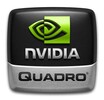ATI Mobility Radeon HD 4830 vs NVIDIA Quadro K510M
ATI Mobility Radeon HD 4830
► remove from comparisonThe AMD ATI Mobility Radeon HD 4830 is a slower clocked Mobility HD 4860 and based on the 40nm RV740 core. Therefore, it is similar to the desktop HD 4700 series. Because of the 40nm production process, the power consumption should be similar to the HD 4670 (according to rumors).
Instead of GDDR5 memory of the HD 4860, the 4830 can be only equipped with slow DDR3 or faster GDDR3. Therefore, the 128 Bit memory bus becomes a bottle neck and the performance is clearly degraded.
The gaming performance of the ATI Mobility Radeon HD4830 is sufficient for demanding games of 2009 in medium - high details. Our gaming benchmarks (see below) showed that a high preset in Crysis or NFS Shift resulted in barely playable framerates around 25 fps. Less demanding games, are playable in high resolution and detail settings.
The Mobility HD 4830 is based on the RV740 chip and features 640 stream processors (128 5-dimensional shader cores). These cores do the graphic work of the shader- and pixel pipelines of older GPUs. The stream processors are also called ALUs and are grouped in five-way VLIW units. Each of the five instructions of a VLIW bundle has to be independent from the others and therefore the performance depends on the optimization of the driver.
The Mobility Radeon HD 4830 includes the Avivo HD called video technology including an onboard soundchip for 7.1 sound output over HDMI or DisplayPort and the 2nd generation UVD (Unified Video Decoder). This UVD 2 supports full bitstream decoding of H.264/MPEG-4 AVC and VC-1 streams. In addition to this, it also supports dual video stream decoding and Picture-in Picture mode which makes the UVD full BD-Live compliant. Simplified, the Avivo HD technology handles all video tasks and enables the GPU to decode HD videos.
The HD4830 was replaced by the Mobility Radeon HD 5830, which features a higher shader count (800) and DirectX 11 capable shaders. Therefore, the gaming performance of the 5830 is better, but also the power consumption should be higher (same 40nm process, although more mature).
Compared to the desktop cards, the Mobility Radeon is similar to the ATI Radeon HD 4730. Still, the desktop 4730 offers a noticeable higher performance due to GDDR5 usage and higher clock speeds.
NVIDIA Quadro K510M
► remove from comparison
The NVIDIA Quadro K510M is a DirectX 11 and OpenGL 4.3 compatible graphics card for affordable mobile workstations. It is a Kepler-based GPU built on the GK107 chip with 192 out of 384 shader cores activated and is manufactured in 28nm at TSMC. The Quadro K510M is built for the Intel Shark Bay generation (Haswell) and is a successor to the Quadro K500M (Chief River platform). As a new feature, PCIe 3.0 is supported for the first time. The K510M usually comes with 1 GB GDDR5 VRAM clocked at 600 MHz (2400 MHz effective, 19.2 GB/s).
The Quadro series offers certified drivers that are optimized for stability and performance in professional applications like CAD or DCC. OpenGL performance, for example, should be significantly better than with GeForce graphics cards of similar specifications.
Architecture
The Kepler architecture is the successor to the Fermi architecture that first appeared in laptops with the GeForce 400M series. The GK107 Kepler core offers two shader blocks, called SMX, that are clocked at the same speed as the central core. In the K510M, only one block is active leading to the 192 CUDA cores. Although more shader cores are available in the Kepler architecture as compared to the Fermi design, the Kepler shaders are still expected to be up to twice as power efficient. However, due to the missing hot clock of the shader domain, two shaders of a Kepler chip offer similar performance to just one shader of a Fermi chip (as the latter is clocked twice as fast).
Performance
The performance should be clearly above the old Quadro K500M, but somewhat below the higher clocked Quadro K610M. This would place the K510M between the consumer GPUs GeForce 710M and GT 720M. However, the exact core clock has not yet been confirmed. Nevertheless, most demanding games of 2013 will run fluently only in low detail settings.
Features
The improved feature set now includes support for up to 4 active displays. Furthermore, high resolution monitors of up to 3840 x 2160 pixels can now be connected using DisplayPort 1.2 or HDMI 1.4a if available. HD-Audio codecs, such as Dolby TrueHD and DTS-HD, can be transmitted via bitstream mode through the HDMI port. However, as most laptops will feature Optimus, the integrated GPU will likely have direct control over the display ports and may limit the feature set available by the Nvidia Kepler cards. Please note: The K510M does not supprt 3D Vision Pro.
Using CUDA or OpenCL 1.2, the cores of the Quadro K510M can be used for general calculations.
The 5th generation PureVideo HD video processor (VP5) is also integrated in the GK107 core and offers hardware decoding of HD videos. Common codecs such as MPEG-1/2, MPEG-4 ASP, H.264 and VC1/WMV9 are fully supported up to 4K resolutions while VC1 and MPEG-4 are supported up to 1080p. Two streams can be decoded in parallel for features such as Picture-in-Picture. Another novelty is the inclusion of a dedicated video encoding engine similar to Intel QuickSync that can be accessed by the NVENC API.
The power consumption of the Quadro K510M is rated at a TGP of 30 W including the board and memory components. Therefore, the card is suited for medium-sized notebooks with 15-inch displays or greater.
| ATI Mobility Radeon HD 4830 | NVIDIA Quadro K510M | ||||||||||||||||||||||||||||||||||||||||||||||||||||
| Quadro K Series |
|
| |||||||||||||||||||||||||||||||||||||||||||||||||||
| Codename | M97 | ||||||||||||||||||||||||||||||||||||||||||||||||||||
| Architecture | Terascale 1 | Kepler | |||||||||||||||||||||||||||||||||||||||||||||||||||
| Pipelines | 640 - unified | 192 - unified | |||||||||||||||||||||||||||||||||||||||||||||||||||
| Core Speed | 550 MHz | 846 MHz | |||||||||||||||||||||||||||||||||||||||||||||||||||
| Memory Speed | 700 MHz | 2400 MHz | |||||||||||||||||||||||||||||||||||||||||||||||||||
| Memory Bus Width | 128 Bit | 64 Bit | |||||||||||||||||||||||||||||||||||||||||||||||||||
| Memory Type | GDDR3, DDR3 | GDDR5 | |||||||||||||||||||||||||||||||||||||||||||||||||||
| Shared Memory | no | no | |||||||||||||||||||||||||||||||||||||||||||||||||||
| API | DirectX 10.1, Shader 4.1 | DirectX 11, Shader 5.0, OpenGL 4.3 | |||||||||||||||||||||||||||||||||||||||||||||||||||
| Transistors | 826 Million | 1.3 Billion | |||||||||||||||||||||||||||||||||||||||||||||||||||
| technology | 40 nm | 28 nm | |||||||||||||||||||||||||||||||||||||||||||||||||||
| Features | Powerplay, CrossFireX support, | Optimus, PhysX, Verde Drivers, CUDA, OpenCL 1.2, 3DTV Play | |||||||||||||||||||||||||||||||||||||||||||||||||||
| Notebook Size | large | medium sized | |||||||||||||||||||||||||||||||||||||||||||||||||||
| Date of Announcement | 03.03.2009 | 23.07.2013 | |||||||||||||||||||||||||||||||||||||||||||||||||||
| Information | 512 - 768 GFlops Computing Power | ||||||||||||||||||||||||||||||||||||||||||||||||||||
| Link to Manufacturer Page | ati.amd.com | www.nvidia.de | |||||||||||||||||||||||||||||||||||||||||||||||||||
| Max. Amount of Memory | 1024 MB | ||||||||||||||||||||||||||||||||||||||||||||||||||||
| Power Consumption | 30 Watt |


 Deutsch
Deutsch English
English Español
Español Français
Français Italiano
Italiano Nederlands
Nederlands Polski
Polski Português
Português Русский
Русский Türkçe
Türkçe Svenska
Svenska Chinese
Chinese Magyar
Magyar






